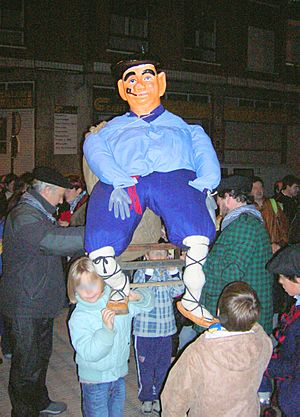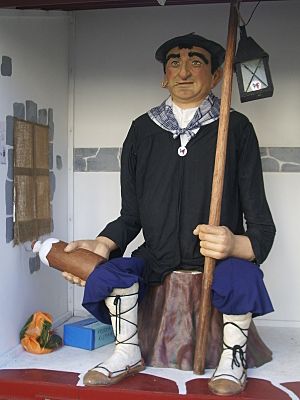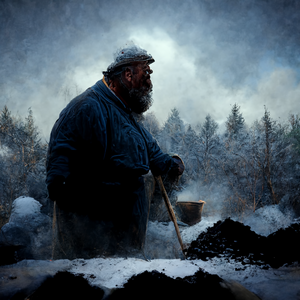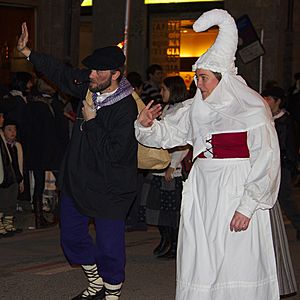Olentzero facts for kids
Olentzero is a special character from the Basque Country's Christmas traditions. People in the Basque Country believe that Olentzero visits towns late on December 24th. He brings gifts for children, just like Santa Claus! In some places, he might even arrive a bit later, like on December 27th or 31st.
Contents
What's in a Name?
The name Olentzero has been spelled in many ways over time, like Onentzaro or Olentzaro. The oldest records show it as Onentzaro. This name likely means "time of the good ones." It's similar to how the Spanish word for Christmas Eve, Nochebuena, means "good night." This suggests that the tradition of Olentzero is very old, even older than Christmas itself, possibly linked to the winter solstice.
The Legend of Olentzero


There are many different stories about Olentzero, and they can change from one village to another. One of the first times Olentzero was written about was in the 1600s. He was described as part of "the season of the good ones."
One popular story says that Olentzero was one of the Jentillak. These were a race of giants who lived in the Pyrenees mountains. One day, the giants saw a bright, glowing cloud in the sky. Only their oldest, nearly blind friend could look at it. He told them it was a sign that Jesus would be born soon. Some versions of the story say the old man asked the giants to throw him off a cliff because he didn't want to live in a Christian world. After they did, the other giants accidentally fell and died too, except for Olentzero.
Other stories say that the jentillak simply left, and Olentzero was the only one who stayed behind to become a Christian.
Some parts of the Olentzero legend remind us of very old traditions from the winter solstice. These traditions often involved special meals and ideas about new beginnings.
Another version of the story, called Olentzeroren kondaira, tells that Olentzero was a baby found abandoned in the woods. A fairy found him and gave him the name Olentzero. She also gave him special gifts of strength and kindness. The fairy then gave him to an older couple who lived alone in the woods and had no children. Olentzero grew up to be a strong man who worked as a charcoal burner. He was also very good at making things with his hands, especially wooden toys. He would carry these toys in a big charcoal bag and give them to the children in the village. It is said that one day he died while saving children from a burning house. When he passed away, the fairy who had found him granted him eternal life. This way, he could continue to bring happiness to children and people forever.
There are also other interesting customs and stories about Olentzero:
- In Areso, children were told to come home early. An adult would dress up as Olentzero and playfully scare children who were still outside.
- In Uharte-Arakil, a figure of Olentzero was traditionally hung from a window with a straw cloak. In Lekunberri, the figure was attached to the chimney.
- In Dima, a straw puppet dressed as Olentzero was hung from the church tower after midnight mass on Christmas Eve.
- In Larraun, he was called Ononzaro. He was said to have three eyes and was often shown as a bit messy, dressed like a scarecrow. People would ask him a riddle: "Olentzero of the red eyes, where did you catch that fish?" And the answer would be: "Last night at eleven on the rocks of Zurriola."
Olentzero Today
Around 1952, during a time when Spain was under strict rule, a group from Zarautz started to bring back the Olentzero traditions. They removed some of the older, scarier parts to make Olentzero more friendly for young children. From 1956, these new Olentzero traditions began to spread. In the 1970s, Olentzero started to become known as a gift-giver. This was a way to have a Basque alternative to other gift-bringers like the Magi (Three Wise Men) in Spain or Père Noël in France. Today, Olentzero is celebrated all over the Basque Country. He often appears alongside the Magi, Père Noël, and Father Christmas. Some families even celebrate more than one of these traditions!
In modern times, Olentzero is seen as a kind and lovable character. He is often shown as being a bit chubby, with a big appetite. He looks like a Basque farmer, wearing a traditional Basque beret, farmer's clothes, and abarketa shoes. He is also often shown smoking a pipe. Sometimes his face is smudged with charcoal, showing his job as a charcoal-burner. On Christmas Eve, groups of people or children carry figures of Olentzero through the streets. They sing Olentzero songs and collect food or sweets. This is similar to "trick or treat" in America or the traditions around Santa Ageda in the Basque Country. In some places, like Lesaka, it's a custom to burn the Olentzero figure at the end of the celebration.
The traditions still vary a lot, depending on the region and whether people focus more on the old pagan ideas or the Christian aspects of Olentzero. Near the sea, he might have more connections to the ocean. Inland, he remains more connected to rural life.
Since 1994, Olentzero has often been joined by Mari Domingi. She is a character who was mentioned in an old Basque Christmas song. Mari Domingi is shown as a woman wearing traditional medieval Basque clothing. Her addition helps to make the Basque Christmas gift-giving tradition more balanced, with both a male and female character.
Olentzero Songs
Just like other European Christmas carols, there are special Olentzero kantak (Olentzero songs). Here are two popular ones:
Olentzero
|
|
Olentzero buru handia
The title of this song means "Olentzero big head." An arroba is an old measurement, a bit more than 11 kilograms.
|
|
Images for kids
See also
 In Spanish: Olentzero para niños
In Spanish: Olentzero para niños




